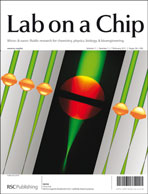Separation and detection of rare cells in a microfluidic disk via negative selection†
Abstract
Cyto-analysis of rare cells often requires separation and detection with each procedure posing substantial challenges. This paper presents a disk-based microfluidic platform for both procedures via an immunomagnetic negative selection process. The microfluidic platform's unique features include a multistage magnetic gradient to trap labeled cells in double trapping areas, drainage of fluid to substantially shorten detection time, and a bin-like regions to capture target cells to facilitate a seamless enumeration process. Proof-of-concept was conducted using MCF7 as target rare cells (stained with anti-cytokeratin-FITC antibodies) spiked into Jurkat Clone E6-1 non-target cells (labeled with anti-CD45-PE and anti-PE BD magnetic beads). Then, mononuclear cells (MNC) from healthy blood donors were mixed with MCF7s, modeling rare cells, and tested in the disk. Results show a non-linear magnetic coupling effect of the multistage magnet substantially increased the trapping efficacy over that of a single magnet, contributing to the depletion rate of Jurkats, which reaches 99.96%. Detection time is extensively shortened by depletion of 95% of non-cell-containing fluid in the collection area. The average yield of detected MCF7 cells is near-constant 60 ± 10% over a wide range of rarity from 10−3 to 10−6 and this yield also holds for the MCF7/MNC complex mixture. Comparison with autoMACS and BD IMagnet separators revealed the average yield from the disk (60%) is superior to that of autoMACS (37.3%) and BD IMagnet (48.3%). The advantages of near-constant yield, roughly 30 min of operation, an acceptable level of cell loss, and potentially low cost system should aid in cyto-analysis of rare cells.


 Please wait while we load your content...
Please wait while we load your content...